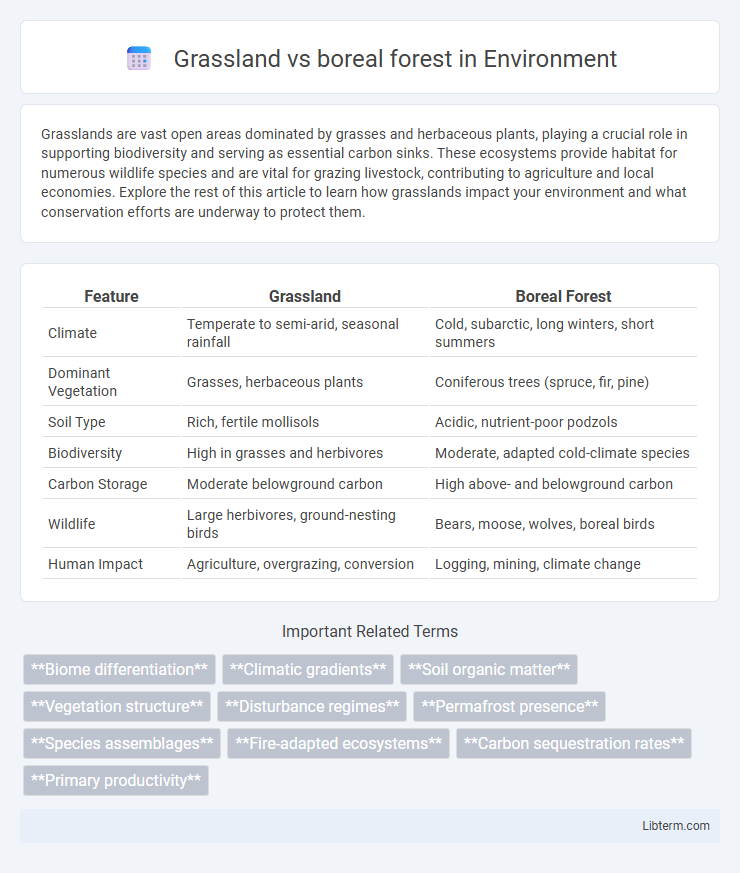Grasslands are vast open areas dominated by grasses and herbaceous plants, playing a crucial role in supporting biodiversity and serving as essential carbon sinks. These ecosystems provide habitat for numerous wildlife species and are vital for grazing livestock, contributing to agriculture and local economies. Explore the rest of this article to learn how grasslands impact your environment and what conservation efforts are underway to protect them.
Table of Comparison
| Feature | Grassland | Boreal Forest |
|---|---|---|
| Climate | Temperate to semi-arid, seasonal rainfall | Cold, subarctic, long winters, short summers |
| Dominant Vegetation | Grasses, herbaceous plants | Coniferous trees (spruce, fir, pine) |
| Soil Type | Rich, fertile mollisols | Acidic, nutrient-poor podzols |
| Biodiversity | High in grasses and herbivores | Moderate, adapted cold-climate species |
| Carbon Storage | Moderate belowground carbon | High above- and belowground carbon |
| Wildlife | Large herbivores, ground-nesting birds | Bears, moose, wolves, boreal birds |
| Human Impact | Agriculture, overgrazing, conversion | Logging, mining, climate change |
Introduction to Grassland and Boreal Forest Ecosystems
Grasslands are expansive open areas dominated by grasses and herbaceous plants, supporting diverse herbivores and adapted to periodic drought and fire. Boreal forests, also known as taiga, consist primarily of coniferous trees like spruce, fir, and pine, thriving in cold climates with long winters and short summers. Both ecosystems play crucial roles in carbon storage, biodiversity, and climate regulation, but differ significantly in vegetation structure, species composition, and environmental conditions.
Geographic Distribution and Global Presence
Grasslands primarily occupy the central regions of continents, such as the Great Plains of North America, the Pampas of South America, and the steppes of Eurasia, thriving in temperate and tropical climates with moderate rainfall. Boreal forests, also known as taiga, dominate the high northern latitudes across Canada, Alaska, Russia, and Scandinavia, representing the world's largest terrestrial biome. This vast forest ecosystem extends over approximately 17 million square kilometers, playing a critical role in carbon storage and supporting cold-adapted flora and fauna.
Climate and Weather Patterns
Grasslands experience semi-arid to sub-humid climates characterized by hot summers and cold winters with moderate rainfall, typically between 300 to 900 millimeters annually, supporting drought-resistant grasses. Boreal forests, or taigas, endure subarctic climates with long, harsh winters often below -20degC and short, mild summers, receiving 300 to 600 millimeters of mostly snow precipitation annually. The stark climatic differences influence biodiversity, with grasslands favoring herbaceous plants adapted to variable moisture, while boreal forests support coniferous trees adapted to cold and snow.
Soil Composition and Fertility
Grassland soils are typically rich in organic matter and nutrients due to the deep-rooted grasses that promote soil fertility and support high agricultural productivity. Boreal forest soils, dominated by coniferous litter, tend to be acidic with lower nutrient availability and slower decomposition rates, resulting in poorer soil fertility. The high organic carbon content in boreal soils is often tied up in undecomposed layers, contrasting with the nutrient-cycling efficiency found in grassland ecosystems.
Dominant Vegetation Types
Grasslands are dominated primarily by herbaceous plants such as grasses and sedges, with few trees due to limited precipitation and frequent fires that inhibit woody plant growth. Boreal forests, also known as taiga, are characterized by coniferous trees like spruce, fir, and pine, adapted to cold climates and acidic, nutrient-poor soils. The contrasting vegetation types reflect adaptations to differing climate conditions, with grasslands thriving in temperate to semi-arid regions, and boreal forests prevailing in subarctic zones.
Wildlife and Biodiversity
Grasslands support diverse herbivores like bison and pronghorn, alongside predators such as wolves and birds of prey, fostering unique plant species adapted to fire and grazing. Boreal forests harbor a rich array of coniferous trees and host large mammals like moose and bears, as well as migratory birds that depend on dense canopy cover. Biodiversity in grasslands is shaped by open, sunlit environments promoting grasses and wildflowers, while boreal forests maintain complex ecosystems with layered vegetation supporting varied wildlife niches.
Adaptations of Flora and Fauna
Grassland flora, such as deep-rooted grasses and drought-resistant shrubs, adapt to periodic fires and limited water availability, while boreal forest plants like coniferous trees develop needle-like leaves with waxy coatings to minimize water loss and withstand cold winters. Grassland fauna, including bison and prairie dogs, exhibit burrowing and migratory behaviors to cope with temperature extremes and sparse tree cover, whereas boreal forest animals such as moose and lynx have thick fur and increased fat reserves to survive harsh, snowy conditions. Both ecosystems demonstrate specialized adaptations that enhance survival, reproduction, and resource utilization in their distinct climates and environmental challenges.
Ecological Roles and Functions
Grasslands store significant amounts of carbon in their deep root systems, supporting biodiversity by providing habitat for numerous herbivores and pollinators. Boreal forests play a crucial role in global carbon sequestration through extensive tree biomass and influence climate regulation by modulating atmospheric gases. Both ecosystems contribute to soil formation and nutrient cycling but differ in species composition and responses to environmental changes.
Human Impact and Land Use
Grasslands face extensive conversion to agriculture and urban development, leading to habitat fragmentation and biodiversity loss. Boreal forests experience logging, mining, and oil extraction that disrupt carbon storage and threaten indigenous communities. Both ecosystems suffer from climate change effects exacerbated by human land use, impacting their ecological balance and resilience.
Conservation Challenges and Sustainability
Grasslands face conservation challenges such as habitat fragmentation, overgrazing, and conversion to agriculture, which threaten biodiversity and soil health. Boreal forests struggle with climate change impacts, increased wildfire frequency, and logging pressures that disrupt carbon storage and ecosystem balance. Sustainable management requires tailored approaches that protect native species, maintain ecological functions, and balance human use with long-term ecosystem resilience.
Grassland Infographic

 libterm.com
libterm.com